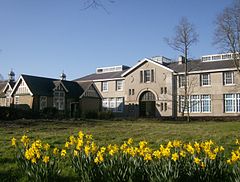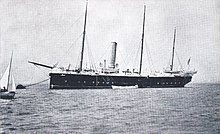Admiral Sir Manley Laurence Power KCB, CBE, DSO & Bar, DL was a Royal Navy admiral who fought in World War II as a captain and later rose to more senior ranks, including the NATO position Allied Commander-in-Chief, Channel. One of his chief accomplishments was leading the 26th Destroyer Flotilla into the Malacca Strait during Operation Dukedom to sink the Japanese cruiser Haguro.
The Commandant of the Royal College of Defence Studies, formerly the Commandant of the Imperial Defence College, is the head of the Royal College of Defence Studies, a British military staff college which instructs senior officers, diplomats, and civil servants.
Stubbington House School was founded in 1841 as a boys' preparatory school, originally located in the Hampshire village of Stubbington, around 1 mile (1.6 km) from the Solent. Stubbington House School was known by the sobriquet "the cradle of the Navy". The school was relocated to Ascot in 1962, merging with Earleywood School, and it closed in 1997.
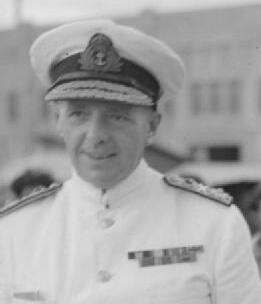
Admiral Sir Arthur Francis Eric Palliser, was a prominent Royal Navy officer during the Second World War.
Admiral Sir Eric John Arthur Fullerton, KCB, DSO was a Royal Navy officer.

Vice Admiral Sir Peter William Gretton was an officer in the Royal Navy. He was active in the Battle of the Atlantic during the Second World War, and was a successful convoy escort commander. He eventually rose to become Fifth Sea Lord and retired as a vice admiral before entering university life as a bursar and academic.
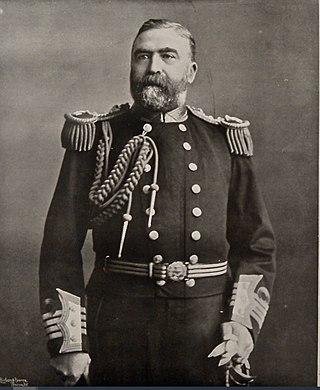
Admiral Sir Hugo Lewis Pearson, KCB was a Royal Navy officer who served as both Commander-in-Chief, Australia Station and Commander-in-Chief, The Nore.
Admiral Sir Walter Thomas Couchman, was a Royal Navy officer who served as Vice Chief of the Naval Staff from February to November 1960, when he retired from service.

Vice Admiral Sir William Geoffrey Arthur Robson, was a Royal Navy officer whose last Service appointment was Commander-in-Chief, South Atlantic.

Admiral Sir Charles Saumarez Daniel, was a Royal Navy officer who went on to be Third Sea Lord and Controller of the Navy.
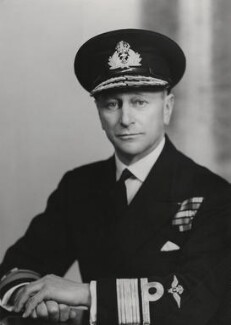
Vice-Admiral Sir Edward Michael Conolly Abel Smith, was a Royal Navy officer who served during the First and Second World Wars.

Vice-Admiral Sir William Gladstone Agnew was an officer of the Royal Navy. He served during the First and Second World Wars, and rose to the rank of vice-admiral.
Eastman's Royal Naval Academy, originally in Southsea and later at Winchester, both in England, was a preparatory school. Between 1855 and 1923 it was known primarily as a school that prepared boys for entry to the Royal Navy. Thereafter, it was renamed Eastman's Preparatory School and continued until the 1940s. According to Jonathan Betts, it was "considered one of the top schools for boys intended for the Navy".
Vice Admiral Sir Cecil Charles Hughes-Hallett KCB CBE (1898–1985) was a senior Royal Navy officer.
The King's Birthday Honours 1950 were appointments in many of the Commonwealth realms of King George VI to various orders and honours to reward and highlight good works by citizens of those countries. The appointments were made to celebrate the official birthday of the King, and were published in supplements to the London Gazette of 2 June 1950 for the British Empire, Australia, Ceylon and New Zealand.
The 1949 King's Birthday Honours were appointments by many of the Commonwealth Realms of King George VI to various orders and honours to reward and highlight good works by citizens of those countries. The appointments were made "on the occasion of the Celebration of His Majesty's Birthday", and were published in supplements to the London Gazette of 3 June 1949 for the British Empire, New Zealand, India and Ceylon.
The 1945 New Year Honours were appointments by many of the Commonwealth realms of King George VI to various orders and honours to reward and highlight good works by citizens of those countries. They were announced on 1 January 1945 for the British Empire, Canada, and the Union of South Africa to celebrate the past year and mark the beginning of 1945.
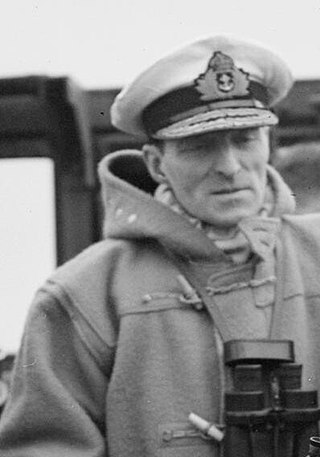
Vice Admiral Sir John Maurice Mansfield KCB, DSO, DSC was a Royal Navy officer who became Flag Officer Submarines.
William George Elmhirst Ruck-Keene MVO was an Admiral of the Royal Navy.
Vice Admiral Sir Hilary Worthington Biggs, was a senior Royal Navy officer.
